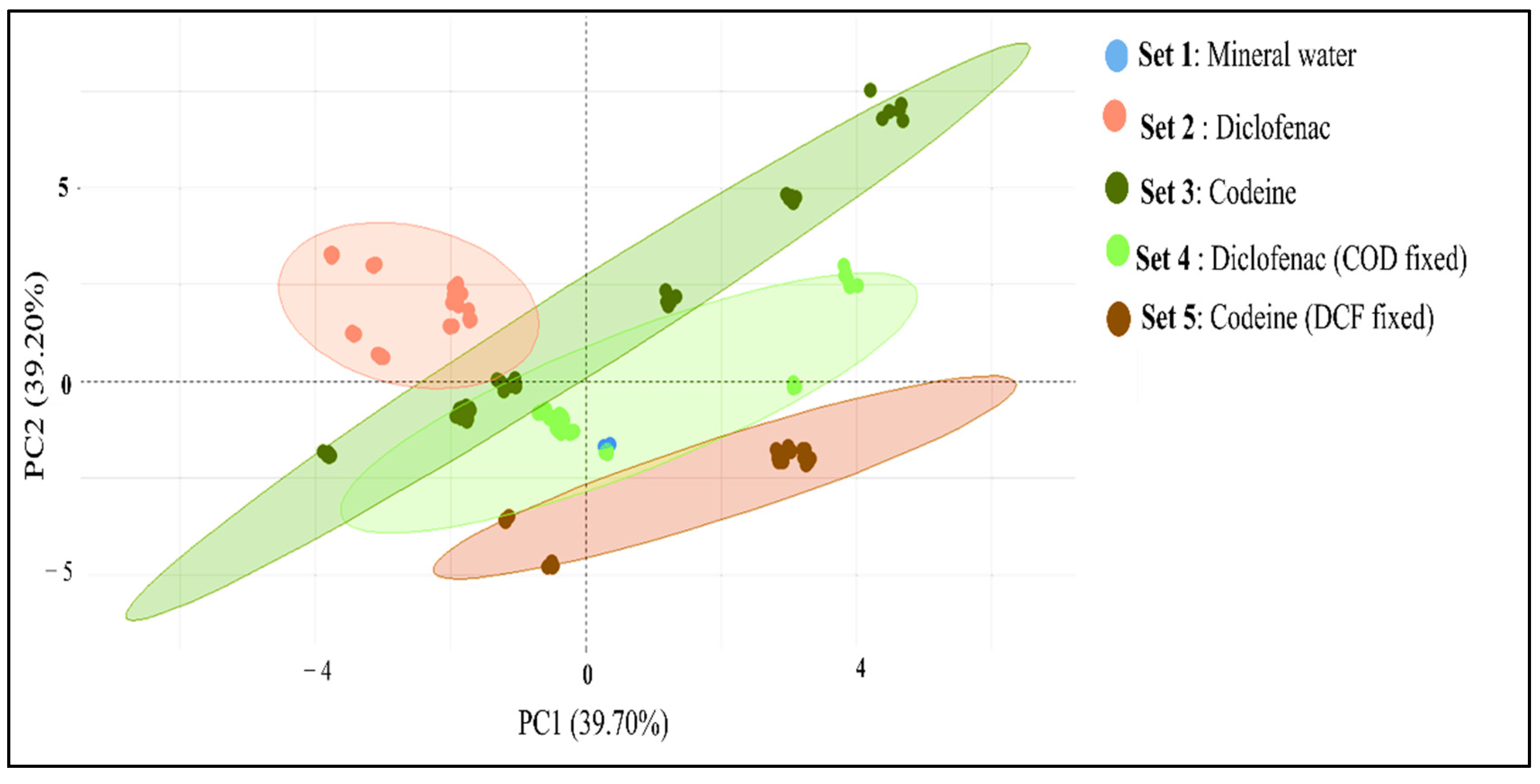Simultaneous Sensing of Codeine and Diclofenac in Water Samples Using an Electrochemical Bi-MIP Sensor and a Voltammetric Electronic Tongue †
Abstract
:1. Introduction
2. Materials and Methods
2.1. Samples
2.2. Instrumentation and Electrochemical Techniques
2.3. Bi-MIP Sensor Preparation
2.4. Data Analysis
3. Results and Discussion
3.1. Biomimetic Receptor Assembly
3.2. Bi-MIP Sensor Responses
3.3. PCA Analysis of the VE-Tongue Dataset
4. Conclusions
Author Contributions
Funding
Institutional Review Board Statement
Informed Consent Statement
Data Availability Statement
Acknowledgments
Conflicts of Interest
References
- Kormosh, Z.; Hunka, I.; Bazel, Y.; Laganovsky, A.; Mazurenko, I.; Kormosh, N. Determination of diclofenac in pharmaceuticals and urine samples using a membrane sensor based on the ion associate of diclofenac with Rhodamine B. Open Chem. 2007, 5, 813–823. [Google Scholar] [CrossRef] [Green Version]
- Elbalkiny, H.T.; Yehia, A.M.; Safáa, M.R.; Elsaharty, Y.S. Potentiometric diclofenac detection in wastewater using functionalized nanoparticles. Microchem. J. 2019, 145, 90–95. [Google Scholar] [CrossRef]
- Häkkinen, M.; Launiainen, T.; Vuori, E.; Ojanperä, I. Comparison of fatal poisonings by prescription opioids. Forensic Sci. Int. 2012, 222, 327–331. [Google Scholar] [CrossRef] [PubMed]
- Tobias, J.D.; Green, T.P.; Coté, C.J. Codeine: Time to say “no”. Pediatrics 2016, 138, e20162396. [Google Scholar] [CrossRef] [Green Version]
- Gimenes, D.T.; Cunha, R.R.; de Carvalho Ribeiro, M.M.A.; Pereira, P.F.; Muñoz, R.A.A.; Richter, E.M. Two new electrochemical methods for fast and simultaneous determination of codeine and diclofenac. Talanta 2013, 116, 1026–1032. [Google Scholar] [CrossRef] [PubMed]
- Haddi, Z. Conception et Développement d’un Système Multicapteurs en gaz et en Liquide pour la Sécurité Alimentaire. Ph.D. Thesis, Université Claude Bernard—Lyon I, Lyon, France, 2013. [Google Scholar]
- Motia, S.; Bouchikhi, B.; El Bari, N. An electrochemical sensor based on molecularly imprinted polymer conjointly with a voltammetric electronic tongue for quantitative diphenyl phosphate detection in urine samples from cosmetic product users. Sens. Actuators B-Chem. 2021, 332, 129449. [Google Scholar] [CrossRef]
- Diouf, A.; Bouchikhi, B.; El Bari, N. A nonenzymatic electrochemical glucose sensor based on molecularly imprinted polymer and its application in measuring saliva glucose. Mater. Sci. Eng. C 2019, 98, 1196–1209. [Google Scholar] [CrossRef]






Publisher’s Note: MDPI stays neutral with regard to jurisdictional claims in published maps and institutional affiliations. |
© 2021 by the authors. Licensee MDPI, Basel, Switzerland. This article is an open access article distributed under the terms and conditions of the Creative Commons Attribution (CC BY) license (https://creativecommons.org/licenses/by/4.0/).
Share and Cite
El Youbi, H.; Diouf, A.; Bouchikhi, B.; El Bari, N. Simultaneous Sensing of Codeine and Diclofenac in Water Samples Using an Electrochemical Bi-MIP Sensor and a Voltammetric Electronic Tongue. Chem. Proc. 2021, 5, 63. https://doi.org/10.3390/CSAC2021-10483
El Youbi H, Diouf A, Bouchikhi B, El Bari N. Simultaneous Sensing of Codeine and Diclofenac in Water Samples Using an Electrochemical Bi-MIP Sensor and a Voltammetric Electronic Tongue. Chemistry Proceedings. 2021; 5(1):63. https://doi.org/10.3390/CSAC2021-10483
Chicago/Turabian StyleEl Youbi, Hafsa, Alassane Diouf, Benachir Bouchikhi, and Nezha El Bari. 2021. "Simultaneous Sensing of Codeine and Diclofenac in Water Samples Using an Electrochemical Bi-MIP Sensor and a Voltammetric Electronic Tongue" Chemistry Proceedings 5, no. 1: 63. https://doi.org/10.3390/CSAC2021-10483
APA StyleEl Youbi, H., Diouf, A., Bouchikhi, B., & El Bari, N. (2021). Simultaneous Sensing of Codeine and Diclofenac in Water Samples Using an Electrochemical Bi-MIP Sensor and a Voltammetric Electronic Tongue. Chemistry Proceedings, 5(1), 63. https://doi.org/10.3390/CSAC2021-10483






